Survey of Published Films
and Videos
on the Doukhobors
- Ternistyi put’ / Thorny Road. 1949. Russian. 56 minutes
- Ombudsman. 1977.
- In Search of Utopia: The Doukhobors. 1978. English. 63 minutes.
- Doukhobors: The Living Book and Peaceful Life. 1978. Part One and Part Two. English. Each 28 minutes.
- Russkie Dukhobortsy Kanady [Russian Doukhobors in Canada]. 1986. Russian. 8 minutes.
- The Doukhobors of Saskatchewan. 1987. English. 22 minutes.
- 1987 Dukhobortsy [The Doukhobors 1987]. 1988. Approx. 3 hours.
- The Last Hurrah with sub-title ‘The Man and his Music’. 1990. English. 28 minutes.
- Vstrecha s Dukhobortsami Kanadu [Meeting with Canadian Doukhobors]. 1991. Russian. 68 minutes.
- Borscht. 1993. English. 10 minutes.
- Write it on the Heart / Napishite vo Serdstakh. 1995. English. 23 minutes.
- Voice Within. 1995. 2 hours & 46 minutes. English.
- Centennial Doukhobor Celebrations: Burning of Arms 1995. 1995. English and Russian. 3 hours and 3 minutes.
- Pulling Together—Community Doukhobor Elders. 1995. English. 29 minutes.
- Soul Communion. 1998. English. 52 minutes.
- Centennial Doukhobor Celebrations: Doukhobors – 100 Years in Canada. 1999. English and Russian. 1 hour and 39 minutes.
- Wrestling with the Spirit: A Doukhobor Story. 2000. 23 minutes.
- Through Her Eyes: Daughters of Freedom. 2001. 53 minutes. English.
- My Doukhobor Cousins. 2002. 71 minutes. English.
- The Spirit Wrestlers. 2002. 94 minutes.English. Captioned.
- Anna Markova: Forgiveness in Exile. 2005. English. 25 minutes
- Dukhobory:
Poteriannyi Krai. (Doukhobors. The Lost
Land/Paradise). 2005. Russian. English subtitles
available. Two versions: 35 minutes and 26 minutes.
Reissued on DVD as The
Lost Land: The Red Book of Humanity.
- Tolstoy and the Doukhobors. 2005. Russian and English versions on DVD video. 30 minutes.
- Gorelovka. (research
material for documentary project) 2006. Russian with
English subtitles. Video on YouTube.com. 7 minutes.
- Russian Religious Folklore. 2008. 8-segment video on the Internet of a lecture by Dr. S.E. Nikitina, Institute of Linguistics, Russian Academy of Science. Russian. 26:21 minutes total for 8 segments.
- A
Discovery: The Psalmist Project. A Tribute to BC
Doukhobors 1908-2008. 2009. DVD, 119
minutes.
- Come Home to History! A Tour of the Doukhobor Dugout House, Blaine Lake, Saskatchewan. 2009. English. Colour DVD. 40 minutes.
- Gorelovka - Episodes from the life of a disappearing community 2010, 48 minute documentary proposed in #24 above. Russian with English subtitles.
Not reviewed.
Videos
in Reference to Doukhobors, by Larry Ewashen,
Larry's Desk
- Voices for Peace: 1995 International Tour (1.5 hours)
- Doukhobor Heritage Tour 2015 (time 2 hours, 16 min) -- by Alex and Brian Ewashen. — 25 day tour of Turkey, Georgia, Azerbaijan and Russia, June-July 2015. Text.
- Spirit-Wrestlers: Doukhobors. 3 part documentary by
Vedat Akcayoz, Kars Turkey. Part
1 (14 min.), Part
2 (14 mion), Part
3 (12.5 min)
Introduction
This is a survey and collection of short reviews of
published films and videos on the Doukhobors which are
published and available to the public for purchase, on the
Internet (Larry's
Desk, or at libraries. Many more other films and
videos exist in private collections or which are not
widely available or archived.
Format of survey: Title. Date of origin. Language of narration. Length. Colour format. Format type (VHS, film, DVD). Sub-titles. Producer and narrator. Camera person. Availability. Contents in brief (including reviews).
Acknowledgements:
Sincere acknowledgement is hereby given to Richard
Sokoloski, ‘Images of the Doukhobors: a record of film
sources’ in Canadian Ethnic Studies, vol. XXVII,
no. 3, l995, pp. 281-288. Dr. Sokoloski is Professor of
Polish and Russian literature, Department of Modern
Languages and Literatures, University of Ottawa. In 1995
he examined eleven sources: six films in English, four in
Russian, and one in both languages. All were documentary
in conception, and one consisted of interviews (as yet
unedited). He concluded his review with the following
paragraph:
‘….All of the films described
above are as much a testimony to the endurance of the
Doukhobors in Canada as they are a process of renewal with
which all movements periodically must contend. To the
extent that history seems to have come full circle and has
again begun to feed upon itself in the younger generation
is likely a good sign for the Doukhobors. Ultimately, the
varied images of the Doukhobors that emerge from these
films reveal, in some measure, a timeless sense of
introspection and an affinity for oral dialogue that
implicitly binds the movement to both past and present,
word and deed, thought and belief. Anyone interested in
this fascinating aspect of Canadian-Russian social and
religious history is well-advised to view these films’
(Sokoloski, 1995: 287).
Since that initial scholarly introduction to films on
Doukhobor in 1995, many more have been added to
English-and Russian-language video and cinematographic
sources that may help foster understanding and future
research on the Doukhobors. Readers are invited to submit
additions and suggestions to this study. This is a work in
progress. Contact Koozma.
Ordering: Many of these films are available on loan from your local library, from the producers indicated below, or from The Village Art Gallery/Craft Centre, at the Doukhobor Discovery Centre, Castlegar, BC — most for $20. Some are hard to find.
Film Reviews
 Ternistyi put’ / Thorny Road. 1949.
Russian. 56 minutes. Colour. 16 mm and VHS. The following
credits appear on the film: Commentary: Walter Kazakoff;
Director: H. Melmed, Sun Photo Co., Winnipeg; Produced by:
Angelo Movie Makers, Winnipeg. The film was produced and
sponsored by The Doukhobor Society of North Eastern
Saskatchewan in 1949 to commemorate fifty years of
Doukhobor settlement on Canadian soil. It appears to have
been the first Canadian film to deal with the subject.
Produced at the somewhat extravagant cost (for a film of
this nature) of $10,000, it remains for its age a
remarkable work. Available from: Canadian Museum of
Civilization, Gatineau, Quebec.
Ternistyi put’ / Thorny Road. 1949.
Russian. 56 minutes. Colour. 16 mm and VHS. The following
credits appear on the film: Commentary: Walter Kazakoff;
Director: H. Melmed, Sun Photo Co., Winnipeg; Produced by:
Angelo Movie Makers, Winnipeg. The film was produced and
sponsored by The Doukhobor Society of North Eastern
Saskatchewan in 1949 to commemorate fifty years of
Doukhobor settlement on Canadian soil. It appears to have
been the first Canadian film to deal with the subject.
Produced at the somewhat extravagant cost (for a film of
this nature) of $10,000, it remains for its age a
remarkable work. Available from: Canadian Museum of
Civilization, Gatineau, Quebec.
‘Depicting Doukhobor settlements near Kamsack,
Saskatchewan, the film is a simply made effort by
non-professional technicians (one would assume) who strove
to combine a sense of cultural history with the ethos of
the Doukhobor life-style and beliefs. In terms of content,
re-enactments with commentary depicting the laying down of
arms and relocation in Canada are followed by several
vignettes revealing the lot of the early pioneers engaged
in practical occupations and various manners and mores
(field labour, pulling wagons, gathering “Seneca” grass,
craft-making, weaving, shoe construction, meals, washing,
religious/social customs, rituals). The final third of the
film comprises archival footage drawn from actual jubilee
celebrations at Kamsack, including speeches (in English)
by a visiting American representative of the Quakers, a
Mr.Schaefer; the mayor of Kamsack, Mr. Candle; and a
member of the Saskatchewan legislature, Mr. Banks.
Ombudsman. 1977.
16 mm. Colour. Produced by the Canadian Broadcasting
Corporation.
The CBC program includes an interview with Larry A. Ewashen on the death of Peter V. Verigin and the issue of freedom of information. See LIST
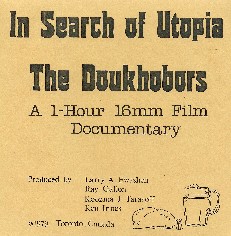 In Search of Utopia:
The Doukhobors. 1978.
English. 63 minutes. Black-and-white. 16 mm.reel-to-reel
and VHS. This historical documentary was directed by Larry
A. Ewashen with research by Koozma J. Tarasoff. Cameraman:
Ray Gallon. Assistant: Ken Innes.
In Search of Utopia:
The Doukhobors. 1978.
English. 63 minutes. Black-and-white. 16 mm.reel-to-reel
and VHS. This historical documentary was directed by Larry
A. Ewashen with research by Koozma J. Tarasoff. Cameraman:
Ray Gallon. Assistant: Ken Innes.
Available from Larry
Ewashen, and posted
on YouTube in 2016 by Larry Ewashen.
From brochure release: ‘This film has drawn on the
original material – the Doukhobors themselves, and
explores the history of the Doukhobors in Canada through
their own words, their own experiences, their own
photographs and their own settlements. It traces the
arrival of the Doukhobors through original documents prior
to and including the 1890s, after which it concentrates on
the interviews and narrations of the Doukhobors
themselves, continuing their history to the present time.
The film is an invaluable collection and documentation of
their entire history in Canada. It is valuable not only as
a documentation of a struggling people whose history
parallels the settling of Canada’s West but also as a
social movement.’
‘….Ewashen and Tarasoff have produced a work of Canadian
historiography that attempts through copious use of
documentation (newspaper articles, archival and personal
photographs, film footage, personal interviews, and
quotations) to present a fair depiction of the Doukhobor
presence in this land. In its content, the film not only
furnishes a thorough background, but also openly explores
a number of controversial aspects of Canadian Doukhobor
history, including immigration and settlement policies,
the more zealous manifestations of …beliefs, the
mysterious death of P. V. Verigin in 1924 (still under
investigation after seventy years), the internment camps
of the Second World War, and the infamous “New Denver”
incident in the fifties. Technically, the film exhibits a
high degree of professionalism, employing documentary
techniques in an effective manner. Made possible by grants
from the offices of the Canadian Multicultural Programs,
Secretary of State, and the Ontario Arts Council; In
Search of Utopia uses primary and secondary
materials from a number of sources; items and institutions
consulted include The Public Archives of Canada, The
National Film Board of Canada, The Provincial Museum of
Alberta, The Thomas Fisher Rare Book Library of the
University of Toronto (The James Mavor Papers), The
Verigin Museum, and The Glenbow Alberta Institute, as well
as various Canadian newspapers and sources of personal
correspondence’(Sokoloski, 1995: 282-283).
Here is another review of In Search of Utopia by
anthropologist F. Mark Mealing, ‘Film Review’ in Canadian
Ethnic Studies, XII, 1, 1980: 113-114:
‘There are now four prime sources of visual material
dealing with Doukhobors in Canada: the Tarasoff Photo
Collection in the B.C. Provincial Archives; Tarasoff’s Pictorial
History of the Doukhobors (Saskatoon, Western
Producer Press, 1969); the CBC/NFB two-part 16 mm film The
Doukhobors: The Living Book/Toil and Peaceful Life (each
27 min., 1976); and now Larry Ewashen’s In Search of
Utopia. The Photo Collection is not portable, and
the Pictorial History is out-of-print; but In
Search of Utopia draws upon and adds to these
sources and renders them both available and portable.
‘The film is in essence an extended historical essay
conveyed for the most part by standard still animation,
with some historic and recent live film footage. The
narrated sound discussion draws upon historical documents,
sound-over of Doukhobor traditional song, and interview
segments or transcription from individual informants. It
is clear that Ewashen and Tarasoff see eye-to-eye on the
use and evaluation of a wide range of photographic
materials, repeating the excellent breadth of Tarasoff’s Pictorial
History by informed and dramatic examination of a
set of images that ranges from antique set-pieces of
almost ritual formality through media excerpts and dossier
materials to informal snapshots of family events. The
resulting depth of imagery acquaints the viewer with a
diverse and profound presentation of the Doukhobor
presence in Canada.
‘Doukhobors in Canada belong to three major sub sects.
The viewpoint of the film is largely that of the
Independent Doukhobors, the group that has developed the
widest interface with the majority culture. Community
Doukhobors and the conservative radical Svobodniki
(Sons of Freedom) might disagree with some of the points
offered by the film, but would, I believe, consider such
issues as debatable rather than illegitimate. In the 1976
CBC/NFB film, the narrator George Woodcock took the view
that Doukhobor culture was rapidly eroding: In Search
of Utopia tends to see most Doukhobors as victims (a
view not without strong historical justification), and the
Independents as the group presently most adapted for
cultural survival. The realities are not quite so
cut-and-dried; but it is ample to the credit of the
Ewashen film that, though a certain view is presented, the
evidence is not edited to fit, and the film stimulates
review and questioning of the issues it raises.
Doukhobors: The Living
Book and Peaceful Life. 1978. Part One
and Part Two. English. Each 28 minutes. Colour. Brief
history written by George Woodcock. The following credits
appear on the film: Producer Gordon Babineau; Camera: John
Seale, Dick Bellamy; Sound Recording: Norman Rosen; Film
Editor: John Fuller; CBC Vancouver. Available from The
National Archives of Canada, Audio-visual Collection,
Ottawa, Ontario.
Posted on YouTube in 2016, Part
1, Part
2, by Larry Ewashen.
‘The two-part CBC effort... another excellent scholarly
work which also places its theme in broad historical
perspective, is nonetheless primarily a study of
Doukhobors as a religious-social phenomenon per se.
With narration written and spoken by George Woodcock, who
has published prolifically on the subject, part one, The
Living Book, provides detailed material on
fundamental aspects of Doukhobor existence: the basis of
their philosophy and beliefs, the habitual and ritualistic
features of their religion, their institutional and
administrative structures, and their evolution into
various factions. Formally, the film moves repeatedly
between Canada and Russia, effectively telescoping large
segments of social and political history, in order to
highlight a number of key points relating to the
philosophy of Doukhoborism. It explores the basis of
crucial divergences with traditional aspects of Orthodoxy,
including the rejection of sacred icons, Holy Writ, the
priesthood, and the liturgy, while also emphasizing such
specific Doukhobor manifestations as ritualized bowing and
kissing, the molenie or prayer-meeting, the sobranie
or secular council, the organization and function of the
Doukhobor prayer-house, and social conventions such as
funerals.
‘Toil and Peaceful Life, a phrase that epitomizes the Doukhobor lot, traces the evolution of the ideal against past and present realities of Canadian life. The first half of the film outlines the contrasting aspects of progress and reaction as collective beliefs were confronted with the competitive material world of the Canadian free market, or as Woodcock states, as “economic communism for religious ends was adapted to a complex industrial administration.” Much attention is devoted to the often misunderstood faction of the “Sons of Freedom” …whose provocative and activistic presence has often lent discredit to the movement as a whole. The latter portion of the film deals with contemporaneity and the ever-present issue of remaining true to past ideals. In one of the final segments, a Doukhobor youth choir singing “This land is your land, this land is my land” in both Russian and English symbolizes the tenacity of Canadian Doukhobors to preserve and defend “the living word” of their founding beliefs from the encroaching realities of their future. In many ways, The Living Book and Toil and Peaceful Life are logically built on the historical foundations of In Search of Utopia. Both parts judiciously incorporate archival material gleaned from a variety of sources, including the National Archives of Canada, and the British Columbia and Alberta Provincial Archives’ (Sokoloski, 1995: 283). See LIST
Russkie Dukhobortsy
Kanady [Russian Doukhobors in Canada]. 1986.
Russian. 8 minutes. Colour. Produced by Alexei Melnikov (Ocherk
Productions) for Soviet television, Channel 1.
‘The short piece, Russkie Dukhobortsy Kanady…was assembled by a Soviet journalist, Alexei Melnikov, during his six-year assignment in Canada in the heady days of the Gorbachev period, is at a best a cursory survey of the subject. It has historical importance in that it was the first (1986) formal sustained reportage on the subject of Canadian Doukhobors that Russian viewers had seen in recent times. This short film report was replayed several times on national Soviet television during the mid and late 1980s, Melnikov considers this to be one of the best assignments of his stay in Canada. See LIST
The Doukhobors of
Saskatchewan.
1987. English. 22 minutes. Colour. Credits: Director: June
Morgan; Writer/Producer: Carol Blenkin; Editor: Terry
Stoker; Cameras: Bob Armstrong, Bob Curtis, George Hupka,
Brian Langdon, Gary Von Custer; Studio Camera: Ron Hanlin.
Aired 30 January 1995 on station BBS (CFQC TV), Saskatoon,
Saskatchewan.
This film was structured for a half-hour television
program and conceived for a larger, more popular, viewer
ship. It provides a balanced account of the subject, free
of stereotypical bias, of the origins, history and
evolution of the Doukhobor movement.
1987 Dukhobortsy [The Doukhobors
1987]. 1988. Approx. 3 hours. Colour. Producer and
Cameraman: Ilya Frez. Research by Prof. S.E. Nikitina,
folklorist from the Institute of Russian Language, Moscow.
Available at the Smithsonian Institute, Washington, DC.
‘A penultimate item, 1987 Dukhobortsy…unfortunately provided inaccessible for viewing by this author, hence can only be described rather sketchily on the basis of second-hand information. Produced independently by Ilya Frez, a young Russian film-maker (son of a slightly better known Soviet film-maker of the same name), the work was assembled after some twelve hours of shooting, much of which was done in 1987 with Russian Doukhobors from the area of Novgorod. Frez was accompanied in his research by Prof. S.E. Nikitina….The work is notable in that it apparently contains rare archival footage of the Doukhobors shot in Russia during the ‘twenties. Shortened eventually to approximately three hours in length and broadcast on Russian television, the film has not been distributed abroad, all attempts by the producer having been unsuccessful’ (Sokoloski, 1995: 286). See LIST
 The Last Hurrah with
sub-title ‘The Man and his Music’. 1990. English. 28
minutes. Colour. Produced, directed and filmed by Larry A.
Ewashen. Available from Larry E. Ewashen.
The Last Hurrah with
sub-title ‘The Man and his Music’. 1990. English. 28
minutes. Colour. Produced, directed and filmed by Larry A.
Ewashen. Available from Larry E. Ewashen.
‘The Last Hurrah…is a warm biographical look at a
noted figure within the Doukhobor community, Nick
Kalmakoff, whose collections of Doukhobor choral
adaptations of psalms and hymns, gathered and published
over the course of six decades, constitute an invaluable
contribution to Canadian musical ethnography. An affable
individual with wise scholarly foresight, Kalmakoff and
his lengthy responses to Ewashen’s questions constitute
the main narrative thread of the film. Kalmakoff reveals
the origins of his interest in sacral music; the
philosophical, spiritual and ritualistic basis of the
Doukhobors’ love of song; the inception of certain
individual hymns; their subsequent development and
popularity; his own criteria in compiling a collection or
sbornik, and the characteristics of performance in
general. Also included is a short segment with Jack
McIntosh, Slavic bibliographer at the University of
British Columbia library…and with Dr. Shirley Perry, who
is presently engaged in the large-scale project of
establishing a system of musical annotation for the
complex modes of Doukhobor choral performance.
Vstrecha s
Dukhobortsami Kanadu [Meeting with Canadian
Doukhobors]. 1991. Russian. 68 minutes. Colour. The
following credits appear on the film: Director: Vera
Novikova; Photography: Victor Epstein; Camera: Yury
Saranduk; Composer: Igor Yefremov; Sound: Vladyslav
Torohov; Conductor: Sergei Skripka; Producer Ludmila
Ivanova. Available from Canadian Museum of Civilization,
Gatineau, Quebec.
‘…Meeting with Canadian Doukhobors like In Search of
Utopia and The Living Book / Toil and Peaceful
Life, is also a scholarly full-length account of the
subject, though here an attempt has been made to provide
more in-depth background on the native origins, evolution
and vicissitudes of the Doukhobors in their original
homeland. While intended obviously for the Russian viewer,
the film provides an interesting and informative
compliment to the two longer English-language works
mentioned above. Made in the emerging post-glasnost
period (1991), Meeting with Canadian Doukhobors
is generally a balanced unbiased account of a subject
which many Russians have only recently begun to reclaim
and study with great interest.
‘The work touches on the beginnings of the Doukhobor
movement in the eighteenth century, focusing on the
philosophical sources of the fledging sect, the
etymological (and ironical) origins of its name, and the
general formulation of its beliefs. Incorporating archival
materials and interviews, the camera takes the viewer to a
number of important historical sites in Russia:
Molochnye Vody [Milky Waters] near the Sea of Azov,
an early area of settlement (1801); more recent places of
settlement in this century within the Salsk Okrug,
south-west of Rostov-on-the-Don; to the Doukhobor Museum,
located in Georgia (Javahetia, or Dzhavakhetii); and to
the restored home (Gorelovka) of an influential figure of
the movement in nineteenth-century Russia, Lukeriia
Vasilevna Kalmykova (c. 1886).
‘In its linear exposition, the film is circular: opening with broad shots of the Canadian landscape, introducing the general theme, moving them in time and space to Russia to retrace the historical origins of the movement, and eventually returning to reassume the initial Canadian impetus of the film, where the evolution of the movement on Canadian soil is outlined. In addition to providing an informative overview of the Doukhobor presence in the new world, this latter section of the film also comprises interesting comments, often solicited through interviews, regarding the thoughts and feelings of Doukhobors toward their ancestral homeland. Similarly, interviews with members of the Doukhobor newspaper Iskra [The Spark], as well as with John J. Verigin, honorary chairman of the Union of Spiritual Communities of Christ, underscore a somewhat more recent concern of the movement, namely, the desire to promote understanding both within and beyond Doukhobor circles by means of education and implementation of media resources. The camera similarly visits a number of historical sights of interest in Canada, including the Verigin Museum and the Verigin Memorial Cemetery’ (Sokoloski, 1995: 285). See LIST
Borscht. 1993.
English. 10 minutes. Colour. The following credits appear
on the film: Director: Anna Kapell; Editing: Cheri Evans;
Camera: Joanne Lyons; Music: Saskatoon, Blaine Lake and
Langham Choirs; produced at Video Verite. Available from
Anna Kapell, Box 866, Kingston, Ontario K7L 4X6.
Anna Kapell, a Kingston, Ontario artist, pays tribute to
her Saskatchewan Doukhobor grandmother Ann Hoodekoff who
works with her hands and displays her skills through
cooking and embroidery. Kapell compresses 27 hours of
video tape into 10 minutes and captures the immediacy,
intimacy, detail and humanity of her Baba’s home life. The
film relies on ‘hands-on’ illustration, as Hoodekoff
performs her art while recounting, in quaint broken
English, the events of her life as a Doukhobor.
The film is a personal and emotional venture for the
artist because most of her contact with Doukhobor culture
has been in her very early years when more Russian was
spoken at her grandparents than and group singing.
Apparently Kapell’s mother had a lot of negative feelings
attached to life on the Saskatchewan farm that when she
packed up at the early age of 14 to move into the city,
she put everything to do with that life behind her. When
she married Kapell’s father, she had to become a Catholic
and the family was consequently raised in that faith.
When Kapell was researching Doukhobor materials, she was simultaneously reading Elaine Pagel’s writings on the Gnostic Gospels. She got excited when she discovered their basic philosophy seemed similar. Both groups were persecuted and the written word was dangerously incriminating to them. Men and women celebrated equally in speaking of the divine which resides within all people. The early Christians, Kapell noticed, revered Christ as a teacher who helped them recognize divinity within themselves. And the hierarchical structure of the church was rejected with disdain. Alana Kapell writes:
‘In my Doukhobor readings, references are frequently made to the early Christians and I feel that the Doukhobors really attempted to keep the early teachings clear and true…’ (Correspondence, April 26, 1993). See LIST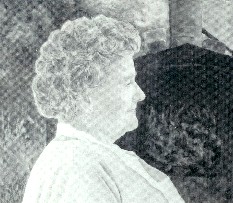 Write it on the Heart / Napishite vo
Serdstakh. 1995. English. 23 minutes. Colour. The
following credits appear on the film: Director: June
Morgan; Writer/Producer: Catherine
Perehudoff, June Morgan; Photography: Dan Semenoff;
Narrator: Eva Petryshen. Produced in association with the
Saskatchewan Communication Network. Available from:
Catherine Perehudoff, Saskatoon, Sask.
Write it on the Heart / Napishite vo
Serdstakh. 1995. English. 23 minutes. Colour. The
following credits appear on the film: Director: June
Morgan; Writer/Producer: Catherine
Perehudoff, June Morgan; Photography: Dan Semenoff;
Narrator: Eva Petryshen. Produced in association with the
Saskatchewan Communication Network. Available from:
Catherine Perehudoff, Saskatoon, Sask.
‘….Write it on the Heart is an informative film whose title is inspired by a proverb from Hebrews (“I will put my laws into their minds, and write them in their hearts”; 8:10). Like the inspiration of its title, the work in many ways focuses on the oral, non-written tradition as an inherent defining factor in the Doukhobor philosophy. Striving to capture the essence of the movement, Write it on the Heart also incorporates abundant excerpts of choral singing, a time-honoured custom and art form of the Doukhobors. Drawing from a number of resources including the Maritime Museum of the Atlantic (Halifax) and The Archives of British Columbia, the film also devotes considerable time to depicting the actual resettlement procedure of the original Doukhobors to Canada, en emigration which constituted the largest number of settlers to arrive on North-American soil at one time. Conceived in a spirit of understanding and acceptance, both films [including The Doukhobors of Saskatchewan] deserve wider distribution (Sokoloski, 1995: 284). See LIST
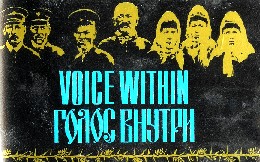 Voice Within. 1995. 2 hours
& 46 minutes. English. Colour. VHS. Project
Coordinators: Ernie Verigin and Leana Zwick. Co-Directors:
Marjorie Malloff, Ernie Verigin and Leana Zwick. Choir
Directors: Leana Zwick and Ernie Verigin. Kootenay
Mens Choir and Spirit of Youth Choir. Cameras: Wallace
Dergousoff, Andy Ozeroff, Steve Malloff, Bill Chiveldave,
Walter Hoodikoff and Ed Chernoff. Video Production by the
USCC Video Club. Produced by the USCC Youth Centennial
Drama Committee. Videotaped live on stage at the Brilliant
Cultural Centre, Castlegar, BC. Available from the USCC
Video Club.
Voice Within. 1995. 2 hours
& 46 minutes. English. Colour. VHS. Project
Coordinators: Ernie Verigin and Leana Zwick. Co-Directors:
Marjorie Malloff, Ernie Verigin and Leana Zwick. Choir
Directors: Leana Zwick and Ernie Verigin. Kootenay
Mens Choir and Spirit of Youth Choir. Cameras: Wallace
Dergousoff, Andy Ozeroff, Steve Malloff, Bill Chiveldave,
Walter Hoodikoff and Ed Chernoff. Video Production by the
USCC Video Club. Produced by the USCC Youth Centennial
Drama Committee. Videotaped live on stage at the Brilliant
Cultural Centre, Castlegar, BC. Available from the USCC
Video Club.
This production was the highlight of the 49th
Annual Youth Festival held at the Brilliant Cultural
Centre, Castlegar, BC May 20, 1995. The Doukhobor youth
produced this drama on stage in honour of their ancestors
who burnt their guns on midnight June 28, 1895 and as part
of the 100th year celebration of this noble act.
This stage production was divided into ten scenes with
one intermission: I.Ekaterinoslav. II. & III.Milky
Waters Region. IV.Doukhobors Move to Transcaucasian
Region. V, VI, VII & VIII. Transcaucasus Region. IX.
Transcaucasus; Military Perspective. X. The Burning of
Guns. More than 40 local youth were cast in their roles
and exhibited a tremendous dedication in the production of
this play which had been in the making for over a year.
The youth also provided singing, set design and stage
construction as well as lighting, sound, costumes and
make-up. A Program pamphlet was available.
Voice Within was a moving dramatization of
Doukhobor history from 1790 to 1899. The play included the
period when the ancestors rejected the Orthodox Church,
staged the huge manifestation for peace during the
rejection of military service in 1895, right up to the
time of their exile to Canada in 1899.
Acappella singing in Russian was an integral part of the
play, often serving along side of lighting effects as the
stage changes. No curtain was used. Colourful costumes and
props aided the authenticity of the play.
The audience of over 1000 people was asked a couple of
times to stand up and give greetings to a married couple
on stage. They were moved to tears on many occasions as
they witnessed the separation of families and loved ones
during a very painful period in their history. In spite of
the beatings of the Russian dissidents – first by the
Russian Orthodox Church and then by the Tsarist officials
– the Doukhobors were not swayed from their beliefs,
morals and ideals.
Centennial Doukhobor
Celebrations: Burning of Arms 1995.
1995. English and Russian. 3 hours and 3 minutes. Colour.
Produced by the National Doukhobor Heritage Village Inc.
Videotaped by LRK Video Productions Ltd., Saskatoon, Sask.
Because of rainy weather, the celebration was held on an
open stage in the Kamsack Arena, Kamsack, Saskatchewan
June 29, 1995.
The video opens with a close shot of Matvey Lebedev’s
grave stone in the Nadezhda Cemetary north of Verigin,
Sask. Lebedev was the hero who with 10 other Doukhobors on
Easter Sunday April 1895 threw down their guns while
training in the Elizavetpol reserve battalion, stating
that war and Christianity are incompatible. The result was
that the dissidents were sent to disciplinary battalion
and exiled along with 60 other Doukhobor young men in
active service who followed their example.
Then the camera focuses on Lebedev’s portrait on stage in
Kamsack. In front, on the main floor, a traditional
Doukhobor sobranie begins with men on one side
and women on the other. Prayers are recited followed by
congregational singing in Russian in acappella style.
Co-chairman Alex Sherstobitoff speaks in English about the
consequences of rejecting military service, including
torture with 80 strikes on the backs of the dissidents. An
elder descendant of Lebedev read a statement in English
confirming the severity of the decision to fulfill the
commandment ‘Thou shalt not kill’. Several descendants
were presented to the sobranie, saying that three
children are still alive, 9 of 11 grand children are alive
as well as 17 great grandchildren.
Eli A. Popoff, writer from Grand Forks, BC, recited a
psalm in Russian which paid a tribute to those Doukhobor
pioneers who gave spirit to their movement by rejecting
the church, icons, and wars. He ends by saying that today
we realize that if we do not get rid of wars, wars will
destroy us.
The sobranie ends with the singing of Spite Orli
Boevye (Sleep on Ye Brave Eagles).
In the afternoon, guests were presented including the
Lieutenant Governor of Saskatchewan J.E.N. Wiebe, Peter W.
Kabatoff as Mayor of Verigin, Saskatchewan, and Bernie
Collins and Ken Kravetz as Members of the Legislative
Assembly of the Province. Ed Tchorzewsky as Deputy Premier
of Saskatchewan said that Doukhobors are respected for
their unwavering commitment to peace. He declared the week
as ‘Peace Week’ in Saskatchewan.
Andy Ozeroff brought greetings from the Union of
Spiritual Communities of Christ (USCC), while Michael
Verigin spoke on behalf of the United Doukhobors of
Alberta. George Stushnoff spoke in English on behalf of
the Doukhobor Cultural Society of Saskatchewan. Laura
Savinkoff spoke in Russian and English as a member of the
Doukhobor Centennial Committee. Personal greetings also
came from the Baha'i faith, Project Ploughshares, Quakers
and Mennonites, and the Regina Peace Council. Alex Wishlow
brought greetings from the Canadian Doukhobor Society.
Alexei M. Kinakin, head of the Council of Doukhobors in
Russia spoke in Russia, as John J. Verigin, Jr.
interpreted in English. Finally, Russian Doukhobor artist
Volodia Gubanov spoke of his assignment in Canada during
this Centennial year.
Pulling
Together—Community Doukhobor Elders. Harvest
of Age series. 1995.
English. 29 minutes. Colour. Produced by Spindlekin
Productions Inc. of North Vancouver, BC and Pastiche
Production of Victoria, as a TV series. Broadcast on
Knowledge Network and Vision TV. A co-venture of the
producers and Health Canada’s Ventures in Independence
program along with support from Canada Multiculturalism,
Telefilm Canada, VanCity Community Foundation, Kootenay
Savings Credit Union, Vision TV, Knowledge Network, and
Saskatchewan Communications Network. Pulling Together
– Community Doukhobor Elders launched the series on
November 15, 1995.
Harvest of Age was billed as a TV first: a series about
the universal experience of growing old through the eyes
of elders in three Canadian cultures. This series of three
half-hour shows depicts old age like it really is – with
both rewards and its problems – as told by seniors
themselves. Each episode offers intimate portraits of
elders from the Italian, Native Indian and Doukhobor
cultures.
The personal and emotional journeys of several Doukhobor
elders from BC's Kootenay Valley was featured as one part
of a series of films televised on TV. Florence
Podovinikoff, 84, reflects on the loss of her husband and
the joys of having her grandchildren nearby. Nick
Denisoff, 65, shows how he carves traditional Doukhobor
wooden ladles and passes the skill on to his grandson,
Mischa. He points out that carving is therapeutic. Maria
‘Grannie’ Soukhorukov, 72, cites several humorous
sketches. Peter Voykin, singer, shares his views about
traditional a cappella singing and its importance to the
preservation of culture. Elder Julia Ozeroff visits a
senior citizens home in Castlegar, BC and talks to the
Doukhobor elders there.
 Soul Communion. 1998.
English. 52 minutes. Colour. VHS. Produced by Sharon Ann
McGowan of Blue Media Limited in association with Vision
TV. Available from Blue Heron Media Ltd., 2979 East 3rd
Avenue, Vancouver, BC V5M 1H7.
Soul Communion. 1998.
English. 52 minutes. Colour. VHS. Produced by Sharon Ann
McGowan of Blue Media Limited in association with Vision
TV. Available from Blue Heron Media Ltd., 2979 East 3rd
Avenue, Vancouver, BC V5M 1H7.
Posted
on YouTube in 2016 by Larry Ewashen.
A one-hour documentary, Soul Communion tells the
powerful story of Doukhobors as seen through the eyes of
contemporary Doukhobor artists and writers, whose personal
histories and creative work are both dramatic and
poignant. The artists and their work featured in the film
are Polly Faminow and Jan Kabatoff. The writers are Eli A.
Popoff, Kathryn Soleveoff Robbie and Vi Plotnikoff.
Koozma’s letter to Sharon McGowan, October 15, 1998:
‘….Your one-hour documentary was professionally done,
excellently executed, and in good taste….Thank you for
adding another important page to the Doukhobor story on
the eve of their 100 years in Canada.
‘The interviews were well integrated with the many
historic photos, good film footage of the past and current
shots. You kept the viewer’s interest by editing out
excess and unnecessary items and going on to the next
item. Besides good images, the sound portion of your film
was effectively done – as a cappella singing came in and
out, often in the background, with periodic sounds of
ships’ horn, train whistles, children playing, and birds
singing. Your transitions were smooth and fitted well.
Your years of work with the National Film Board and
elsewhere showed….
‘Especially, I enjoyed your live historic footage of
women plowing, of Cossacks charging, of the two-tiered
singing in a sobranie, and the New Denver
footage….
‘Your execution of the phenomena of zealotry / Sons of
Freedom was the most problematic. In fact, much attention
was focused on this theme, and there were generalizations
that often were overdone (e.g. all Doukhobors were staunch
vegetarians; all Doukhobors opposed registering their
births, marriages, and deaths, etc.). Many newspaper
headlines underlined the sensational actions of zealots
(e.g. “Doukhobor fanatics”). However, you did make a good
point that the zealots were the forefront of the effort to
stave off assimilation. Also you avoided the pitfalls of
many other productions which focused on the sensational
actions of nudity and burnings. Also you stayed away from
the sensitive issues of splits and leadership. However,
when the smoke clears, what will the public remember? Do
your generalizations reinforce the very things that
Doukhobors have sought to distance themselves from over
the years or do they actually provide understanding of
what the real situation was? This is a question that I
cannot answer at this time, but will await the reaction of
the wider audience.
Centennial Doukhobor
Celebrations: Doukhobors – 100 Years in Canada.
1999. English and Russian. 1 hour and 39 minutes. Colour.
Produced by the National Doukhobor Heritage Village Inc.
Videotaped by John Kalesnikoff and Shirley Swanton. Edited
by Shirley Swanton. Sound by John Kalesnikoff. Titles by
Shirley Swanton. Filmed in the curling rink at the
Doukhobor Heritage Day Celebrations in Verigin,
Saskatchewan, July 17, 1999. Available from John
Kalesnikoff, Box 256, Meota, Saskatchewan SOM 1XO.
 Wrestling with the Spirit: A Doukhobor
Story. 2000. 23 minutes. Colour. VHS.
Location: Blaine Lake, Saskatchewan. Director: Dorothy
Dickie. Producers: Peter Raymont and Lindalee Tracey.
Episode Nine of A Scattering of Seeds – The Creation of
Canada series presented by White
Pine
Pictures. Distributed by McNabb & Connolly, 60
Briarwood Avenue, Port Credit, Ontario L5G 3N6.
Wrestling with the Spirit: A Doukhobor
Story. 2000. 23 minutes. Colour. VHS.
Location: Blaine Lake, Saskatchewan. Director: Dorothy
Dickie. Producers: Peter Raymont and Lindalee Tracey.
Episode Nine of A Scattering of Seeds – The Creation of
Canada series presented by White
Pine
Pictures. Distributed by McNabb & Connolly, 60
Briarwood Avenue, Port Credit, Ontario L5G 3N6.See this video now at SCN (Saskatchewan Community Network) – Season: 4, Episode 9 - Wrestling with the Spirit: A Doukhobor Story. This film aired Feb. 13-14, 2008.
From the VHS cover:
‘Dorothy Dickie’s A Doukhobor Story is a personal
journey into the fascinating life experiences of her
Russian great-grandfather. In April of 1899, Vanya and
Loosha Perverseff came to Canada with 2,300 other
Doukhobors, the third and final wave of Doukhobor
immigrants to Canada. Simple, devout, mostly illiterate
peasants, the Doukhobors were pacifists, persecuted by the
Russian government for refusing to bear arms for Czar
Nicholas II. The Perverseffs settled in Saskatchewan and
started a new life as farmers with the assurance of
freedom. The Doukhobors eventually experienced radical
differences of opinion and fragmented into three groups.
The Perverseffs chose progress and Vanya raised his
children as literate, educated citizens, making a new life
and certain future for generations.
‘Filmmaker Dorothy Dickie leads us through the mystery of
early Canadian Doukhobor life with an evocative mix of
first person reminiscences, archival footage and lovely
scenic landscapes.
‘A Scattering of Seeds celebrates the grit and character of unsung immigrants – regular people – who staked their families and futures on a second chance in Canada. These are films that make the stranger immediately familiar and the beginnings of this country a shared experience.
‘At the root of each story is the instinct to contribute
something, to mark the efforts of a life. Each episode
draws on a rich archive of home movies, photographs,
letters home, diaries and oral history.
Through Her Eyes:
Daughters of Freedom. 2001. 53 minutes. English.
Directed and written by: Christian Bruyere. Based on an
original script by Beverley Straight. Produced by
Daughters of Freedom Inc. A Women's Television Network
Signature Original (renamed W Network). Editor:
Stuart Dejong. Narrator: Nicole Oliver. Camera: Rudi
Kovanic. Sound: Eric Harwood Davis. Archival Film
Research: Beverley Straight. Original music composed by
Graemie Coleman.
33:26 minutes posted on
Archive.org in 2020.
This is a sympathetic story about Kathleen Shlakoff
Makortoff and Helen Chernoff Freeman of the interior of
British Columbia. Both were raised as Sons of Freedom
children. Both were seized in 1956 by the RCMP because
their parents refused to send them to school. Kathleen and
Helen tell their story in New Denver Dormitory and how
they were scarred for life.
The film effectively used much old film footage with
contemporary interviews. Its backdrop for the title was
flames burning homes. There was practically no attempt to
distinguish regular Doukhobors from zealots. The effect is
a stereotype of Doukhobors as fanatic cult – a false and
unfair notion of a peaceful people.
The film ends with Kathleen and Helen meeting in Agassiz, BC with a psychologist Dr. Andrew Feldmar who devises a plan on how the 71 grads from New Denver can deal with their trauma. The plan is fourfold: 1. Construct a permanent marker at New Denver to show Canadians that this forceful education experiment took place in Canada. 2. Set up a research fund for youth. 3. Have the government set up a counseling rehabilitation program for the children. 4. Videotape their stories and place them in a Museum for access to the public. See LIST
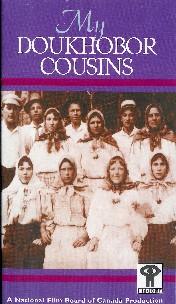 My Doukhobor Cousins. 2002. 71
minutes. English. Closed captioned. Colour VHS. Directed
by Ole Gjerstad. Written by Janice Benthin, descendant of
Sons of Freedom. Producer: Mark Zannis. Editor: Hannele
Halm. Cinematographers: Andrei Khabad and Peter Krieger.
Executive Producer: Sally Bochner. Available from National
Film Board of Canada 1-800-267-7710 (Canada).
1-800-542-2164 (USA). Posted
at Vimeo by film director Ole Gjerstad. Posted
on YouTube in 2012.
My Doukhobor Cousins. 2002. 71
minutes. English. Closed captioned. Colour VHS. Directed
by Ole Gjerstad. Written by Janice Benthin, descendant of
Sons of Freedom. Producer: Mark Zannis. Editor: Hannele
Halm. Cinematographers: Andrei Khabad and Peter Krieger.
Executive Producer: Sally Bochner. Available from National
Film Board of Canada 1-800-267-7710 (Canada).
1-800-542-2164 (USA). Posted
at Vimeo by film director Ole Gjerstad. Posted
on YouTube in 2012.
See
review in CM Magazine, University of Manitoba.
From the NFB brochure:
‘Growing up in the 1950s and ‘60s, Janice Benthin always
felt her family was hiding something. When she vacationed
with [Sons of Freedom] Doukhobor relatives in the BC
Kootenays, the adults spoke Russian in hushed tones,
people disappeared, and RCMP officers kept constant watch
over the community to the disturbing media images of
distraught Doukhobor men and women stripping bare and
setting buildings ablaze. But as a child she was forbidden
to ask questions.
‘My Doukhobor Cousins is Benthin’s quest for
answers [about her Sons of Freedom heritage].
‘The film provides a rare, personal look inside this
mysterious spiritual community of dedicated pacifists who
came to Canada from Russia in 1899 to build a Christian
Utopia. As Leo Tolstoy, a leader to the Doukhobor
community saw it, this group which shunned material
possessions and started the largest experiment in communal
living – was composed of enlightened people centuries
ahead of their time.
‘But soon after their arrival in Canada, the Doukhobor
community fractured. The Sons of Freedom sect was the
smallest, yеt the most visible to other Canadians as they
used arson and nudity to demonstrate their devotion. All
Doukhobors got swept up in the repressions that followed.
‘The film follows Benthin and her cousins Lance and
Marilyn as they attempt to understand the troubled history
of these uncompromising people. They visit the remnants of
a federal prison built in the 1930s specifically to
confine hundreds of Doukhobors arrested for protesting
without clothing.
‘The cousins hear heart-rendering accounts of how
families were torn apart when the BC government cracked
down on the Sons of Freedom and removed hundreds of
children from their families. In one of the most moving
scenes in the film, Benthin finds Vera, a long-lost cousin
who was one of the last children taken away from a
Doukhobor community in the Kootenays; and the story
unfolds further as Vera recounts the challenges and
hardship of her experiences.
Also see review: My Doukhobor Cousins, CM magazine, Vol. XI, No. 6, University of Manitoba, November 12, 2004
See LIST
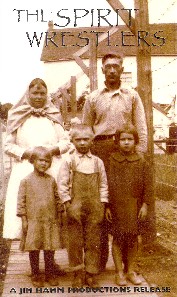 The Spirit Wrestlers. 2002.
94 minutes. English. Captioned. Colour. VHS. Produced and
directed by Jim Hamm Productions Ltd. Available from Jim
Hamm
Productions Ltd., 2555 Trinity Street, Vancouver, BC
V5K 1E3 Canada.
The Spirit Wrestlers. 2002.
94 minutes. English. Captioned. Colour. VHS. Produced and
directed by Jim Hamm Productions Ltd. Available from Jim
Hamm
Productions Ltd., 2555 Trinity Street, Vancouver, BC
V5K 1E3 Canada.
Posted
on YouTube 2016 by Larry Ewashen.
Review by Koozma J. Tarasoff July 2002, entitled ‘The
Spirit Wrestlers Film by Jim Hamm is not about the
Wider Doukhobor Society.’
‘A new documentary is about to be shown on Television on
History Channel on July 31st. The 94-minute
documentary The Spirit Wrestlers by Jim Hamm,
described by him as “a century of Doukhobor Life in
Canada”, unfortunately does not reach the goal of the
Vancouver filmmaker. It is not about the wider Doukhobor
society. This is a film about the Sons of Freedom group
and has value for it.
‘For the first time in film history, Hamm has attempted
to show in depth the causes of burnings, bombings, and
nudity done by an extremist group within the Sons of
Freedom. Using rare archival footage (including police
records) of select historic events and building the story
by way of very interesting interviews with professors,
retired RCMP officers, Sons of Freedom, and Doukhobors,
Hamm’s film skillfully evokes emotions. Very powerful is
the story of the “genocidal” act of Bennett’s BC
Government in forcefully taking away the children in an
attempt to assimilate them through public school
education.
‘Camerawork and sound were professional done, also.
Except for a few minor errors (wrong photo of Peter P.
Verigin; date of the new nudity law was 1931, not 1930;
733,400 acres were granted to the Doukhobors in 1899, not
350,000; and several others), the filmmaker and his team
have generally done their homework on their main focus of
the zealots.
‘The film opens with a full blast of arson and nudity and
it’s shocking to see the title The Spirit Wrestlers
superimposed on those images. There is no connection
between the wider Doukhobor society and that of arson and
nudity. The peaceful Doukhobors have for years lobbied
against the acts of terrorism. This mistake is
discriminatory and not fair!
‘In the content of the 94-minute film, 72 minutes were
devoted to the Sons of Freedom and only 19 minutes to the
Doukhobors. There were 28 clips on burnings and bombings,
31 on nudity, and 39 showed the power of the police. It is
incorrect to use the sub-titled captions “former Sons of
Freedom Doukhobor” for the speakers (15 cases were used).
Instead, ‘brought up in a Sons of Freedom family” (which
was also used) would be more accurate.
‘The real title of Jim Hamm’s film ought to be Sons of
Freedom because it would cover the intended content. This
is not a film about our Doukhobor ancestors and the
contemporary Doukhobors who have preserved and cultivated
for generations the profound rich Doukhobor spirit with
its culture, traditions, and Russian language. Definitely
this is not a film about us! It is sad because once again
a great idea was exploited by sensationalism.
‘Without the change of the title, Jim Hamm will
ultimately fall into the same trap that Simma Holt fell in
her book Terror in the Name of God – The Story of the
Sons of Freedom Doukhobors. Holt’s book was about
the zealots or Sons of Freedom, but not about the
Doukhobors. She described the terrorist acts of the
extremists as if they were part of the philosophy and
behaviour of the wider Doukhobor society. This is
inaccurate and unjust!
‘In comparison, a rough similarity of error would be if
someone today is making a film about the Moslem people and
the content of this film would be 80% on terrorism.
Moslems would be outraged.
‘In my forthcoming book Spirit Wrestlers: Doukhobor
Pioneers’ Strategies for Living, to be released in
the Fall, one of the 100 biographies is on the celebrated
Doukhobor lawyer Peter G. Makaroff who rightly stated many
years back that “the moment a person participates in an
act of violence, he or she automatically removes
him-or-herself from the Doukhobor movement”….
‘Jim Hamm needs urgently to correct the title of the film
before its television premiere on the History Channel at 9
p.m. on July 31st.
‘Perhaps, too, Jim could contemplate doing a sequel: The Real Story of the Spirit Wrestlers.’ See LIST
 Anna
Markova: Forgiveness in Exile. 2005. English. 25
minutes (???). Colour.VHS and DVD. Written, Directed and
Produced by Susan Poizner. Cinematographer: Stefan
Randstrom, Kevin Dimitroff. Editor: Calvin B. Grant.
Website: www.mothertongue.ca Teacher’s
notes included for post-viewing questions.
Anna
Markova: Forgiveness in Exile. 2005. English. 25
minutes (???). Colour.VHS and DVD. Written, Directed and
Produced by Susan Poizner. Cinematographer: Stefan
Randstrom, Kevin Dimitroff. Editor: Calvin B. Grant.
Website: www.mothertongue.ca Teacher’s
notes included for post-viewing questions.
Anna
Markova:
Forgiveness
in Exile is item 3 in a 13-part ‘Mother
Tongue TV’ documentary series that explores women’s
history in ethnic Canada. Each episode tells the story of
a notable woman in one of Canada’s communities.
Most of her family had already escaped persecution in
Russia for a life of freedom in Canada when Anna Markova,
the granddaughter, daughter and mother of three
generations of Russian Doukhobor leaders, disappeared into
Siberian exile in the 1940s.
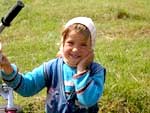 Dukhobory: Poteriannyi Krai [Духоборы:
Потеронной Край] (Doukhobors. The Lost Land / The Lost
Paradise). 2005. Russian. English subtitles available. Two
versions: 35 minutes and 26 minutes. Colour. VHS and DVD.
Shot on location in the Caucasus and Chern area of Russia.
Credits: Producer: Andrei Slastukhin. Director: Svetlana
Kochergina. Scenario: Svetlana Kochergina and Andrei
Slastukhin. Camera: Alexei Krasnov and Pavel Vorob'ev.
Assistants: Roman Kochergin and Vadim Karabanov. Film
editors: Svetlana Kochergina and Alexei Krasnov. Editor:
Larisa Saysina. Composer: Edward Litkin. Sound editors:
Alexei Krasnov and Maxim Burko. Text for off Screen: Sergei
Gurevich and Svetlana Kochergina. Produced by Samara
Information Agency ALNI – TV.Shown at the 9th
"Vertical" film festival in 2006, in the "Mountain and
wild nature" category. See listing in Russian and English
[Name spelling in the English version differs from what is
shown on this page due to transliteration.]
Dukhobory: Poteriannyi Krai [Духоборы:
Потеронной Край] (Doukhobors. The Lost Land / The Lost
Paradise). 2005. Russian. English subtitles available. Two
versions: 35 minutes and 26 minutes. Colour. VHS and DVD.
Shot on location in the Caucasus and Chern area of Russia.
Credits: Producer: Andrei Slastukhin. Director: Svetlana
Kochergina. Scenario: Svetlana Kochergina and Andrei
Slastukhin. Camera: Alexei Krasnov and Pavel Vorob'ev.
Assistants: Roman Kochergin and Vadim Karabanov. Film
editors: Svetlana Kochergina and Alexei Krasnov. Editor:
Larisa Saysina. Composer: Edward Litkin. Sound editors:
Alexei Krasnov and Maxim Burko. Text for off Screen: Sergei
Gurevich and Svetlana Kochergina. Produced by Samara
Information Agency ALNI – TV.Shown at the 9th
"Vertical" film festival in 2006, in the "Mountain and
wild nature" category. See listing in Russian and English
[Name spelling in the English version differs from what is
shown on this page due to transliteration.] Posted on YouTube in 2016 by Larry Ewashen.
In the Caucasus on the Dzhavahetskoe* plateau (2000 m, ) in the rainy Wet Mountains, Doukhobors from Russia settled in 7 villages begining in 1841. In 1900 about 10,000 Doukhobors lived in Ninotsminda rayon – 4500 in 1980, 3000 in 1990, and 1000 in 2004, now most are in Gorelovka. Today, the region is 95% Armenian and Doukhobors are threatened with extinction in independent Georgia. The filmmaker focuses on the Bogdanovka [Ninotsminda] settlement to reveal how the forces of change have seen the rapid out migration of its inhabitants to places such as Cherns Raion south of Lev N. Tolstoy’s Yasnaya Polyana south of Moscow, Briansk and Tambov.
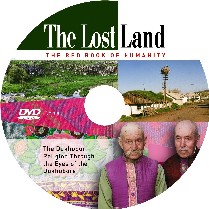 [* also
spelled: Dzhavakhetii, Javahetia, Javakhetia,
Cevaheti (Turkish)]
[* also
spelled: Dzhavakhetii, Javahetia, Javakhetia,
Cevaheti (Turkish)] [More about Doukhboors in Georgia.]
Professional cinematography takes us on a cultural tour of early Doukhobor history, preparing pirozhki (vegetable tarts), sobranie gatherings, historic sites of peshchery (caves), Sirotskii Dom (Orphan’s Home), Georgian landscape, the reading of psalms, a cappella singing, sheep herding, milking cows, the floundering cheese factory, heavenly storks, weddings and funerals, burial grounds of the leaders, drying kiziak (manure bricks for fuel), and women in costume. The stories of collectivization during the 1930s were remembered and retold. Harmony and love are the two traditions that characterize the Doukhobors over the ages, observes the filmmaker.
Re-issued in 2009 with English-languae titles, cover and subtitles (label right) for $20 on DVD as The Lost Land: The Red Book of Humanity Download the promotional flyer (PDF). See LIST
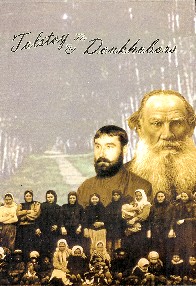 Tolstoy and the Doukhobors. 2005.
Russian and English versions on DVD video. 30 minutes.
Colour. A multimedia project using historic photos.
Narrated by Peter P. Rezansoff. Produced by Pall Musaev.
Script and storyboard by Myler Wilkinson. Creative team:
Seann Einerson, David Tosoff, Bernie K and Fred W.
Makortoff. Multimedia Committee: Peter P. Rezansoff, Paul
Musaev, John J. Verigin Jr., Alex Jmaeff, Koozma J.
Tarasoff, Myler Wilkinson, Fred W. Makortoff, Jim E.
Popoff and Teresa & Ernie Verigin. Choir
contributions: Expo Choir, United Doukhobor Centennial
Choir, Tri Choir, Kootenay Men’s Choir, Repins Family
Album, Krestova Men’s Choir, Krestova Youth Choir, USCC
Dedication Choir, Blaine Lake Doukhobor Choir and the
Georgian Doukhobor Choir. Principal sponsor: Intertech
Construction Group. Russian translation by Vladimir
Tolstoy, Yasnaya Polyana, Tula, Russia. Available from
Peter P. Rezansoff of Intertech Group, 150 Howe Street,
Vancouver, BC V6Z 1N1. Archived website: tolstoy.ca
Tolstoy and the Doukhobors. 2005.
Russian and English versions on DVD video. 30 minutes.
Colour. A multimedia project using historic photos.
Narrated by Peter P. Rezansoff. Produced by Pall Musaev.
Script and storyboard by Myler Wilkinson. Creative team:
Seann Einerson, David Tosoff, Bernie K and Fred W.
Makortoff. Multimedia Committee: Peter P. Rezansoff, Paul
Musaev, John J. Verigin Jr., Alex Jmaeff, Koozma J.
Tarasoff, Myler Wilkinson, Fred W. Makortoff, Jim E.
Popoff and Teresa & Ernie Verigin. Choir
contributions: Expo Choir, United Doukhobor Centennial
Choir, Tri Choir, Kootenay Men’s Choir, Repins Family
Album, Krestova Men’s Choir, Krestova Youth Choir, USCC
Dedication Choir, Blaine Lake Doukhobor Choir and the
Georgian Doukhobor Choir. Principal sponsor: Intertech
Construction Group. Russian translation by Vladimir
Tolstoy, Yasnaya Polyana, Tula, Russia. Available from
Peter P. Rezansoff of Intertech Group, 150 Howe Street,
Vancouver, BC V6Z 1N1. Archived website: tolstoy.ca
This film is a culmination of a Bakery Café and
Communications project which was officially opened in
Yasnaya Polyana, Tula, and Russia on 21st
September 2005. From the DVD jacket: ‘This Bakery Café was
developed in partnership by the Yasnaya Polyana
Administration and the Friends of Tolstoy to commemorate
the centenary of the migration of the Doukhobors from
Russia to Canada in 1899. It stands as testimony to the
enduring gratitude of these Christian pacifists to Lev
Nikolaevitch Tolstoy for his moral and material support in
their time of need, and to the continuing friendship
between the Tolstoy family and the Doukhobor community.’
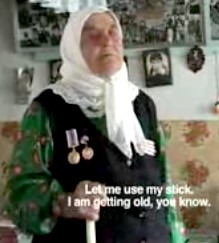 Gorelovka –
Episodes from the Life of a Disappearing Community
— 2010. Russian, English sub-titles, 48 min. Koozma did not
see this complete version. He reviewed the proposed sample/
trailer:
Gorelovka –
Episodes from the Life of a Disappearing Community
— 2010. Russian, English sub-titles, 48 min. Koozma did not
see this complete version. He reviewed the proposed sample/
trailer: The 7 minute Gorelovka (research material for documentary project) is by Alexander Kviria, a native Georgian who was first a journalist, a lawyer, then studied film making in Moscow. This video short video appears to be a proposal for a longer film which came out in 2010. Kviria worked on about 25 films before 2006.
The introduction says:
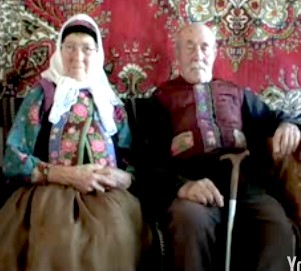 Traditional
Doukhobor psalm singing by several elders in old colourful
costumes frame the documentary as they gather in a sobranie
manner and later walk away from the Doukhobor meeting home.
In one scene, a group of five younger folk are able to
prostrate themselves to the ground in an old outdated ritual
that is no longer vital amongst most Doukhobors worldwide.
Another outdated view is that of two groups: men drinking
together and laughing in contrast to women singing at the
dinner table, a segregated view that is not typical of most
Doukhobors today. In between the viewer sees a wide expanse
of a village, men driving a wagon on horses through harvest
fields of gathered grain, a nice sheep herding scene with a
mountain in the background, the magical stork on top of a
post, and several views of exterior and interior
architecture and handiwork. The film ends with a focus on
the burial site of the ancestral leaders near Orlovka, a
close-up of seven old photos as found in historic pictorials
such as mine, and a focus on an elder couple in traditional
dress sitting inside a Doukhobor home with an old Persian
type rug adorning the wall.
Traditional
Doukhobor psalm singing by several elders in old colourful
costumes frame the documentary as they gather in a sobranie
manner and later walk away from the Doukhobor meeting home.
In one scene, a group of five younger folk are able to
prostrate themselves to the ground in an old outdated ritual
that is no longer vital amongst most Doukhobors worldwide.
Another outdated view is that of two groups: men drinking
together and laughing in contrast to women singing at the
dinner table, a segregated view that is not typical of most
Doukhobors today. In between the viewer sees a wide expanse
of a village, men driving a wagon on horses through harvest
fields of gathered grain, a nice sheep herding scene with a
mountain in the background, the magical stork on top of a
post, and several views of exterior and interior
architecture and handiwork. The film ends with a focus on
the burial site of the ancestral leaders near Orlovka, a
close-up of seven old photos as found in historic pictorials
such as mine, and a focus on an elder couple in traditional
dress sitting inside a Doukhobor home with an old Persian
type rug adorning the wall.Strikingly absent was the presence of youth. In fact, the whole impact on the reviewer is one of gloom and doom. There is no future! This indeed could have been labeled as The Disappearance of a Tradition. A missed opportunity was the filming of the arms burning site of 1895, which is located just barely a kilometer or two from the village. Perhaps that decision says something about the filmmaker's perspective of what constitutes a Doukhobor. — Reviewed May 19, 2009 See LIST
 Russian Religious Folklore.
2008. Russian. 8-segment Interrnet video of a lecture by Dr.
S.E. Nikitina, Institute of Linguistics, Russian Academy of
Science 26:21 minutes. Presented April
9, 2008, 7:30 p.m., “Russian Religious Folklore”, a
lecture in the series: "Following the Expeditions" at
Kaminnom Hall, Club “Art'eria”, Central Moscow. Art'eria is
an old ancient brick hall with excellent acoustics converted
in 2004 into a musical theatre and exhibition center.
Russian Religious Folklore.
2008. Russian. 8-segment Interrnet video of a lecture by Dr.
S.E. Nikitina, Institute of Linguistics, Russian Academy of
Science 26:21 minutes. Presented April
9, 2008, 7:30 p.m., “Russian Religious Folklore”, a
lecture in the series: "Following the Expeditions" at
Kaminnom Hall, Club “Art'eria”, Central Moscow. Art'eria is
an old ancient brick hall with excellent acoustics converted
in 2004 into a musical theatre and exhibition center.Artiom Kirakosov posted this lecture in his video album on the Russian website video.mail.ru in 8-parts totaling almost half an hour. The 8 segments range in time from 1:05 minutes to 5:58 minutes. The first 3 segments show Dr. Nikitina singing dukhovnoye stikhi (spiritual verses) examples from Old Believers, Molokans and Doukhobors. The last 5 segments show a Doukhobor prayer meeting in what looks like the Sirotsky Dom (sobranie) in Gorelovka, Republic of Georgia (See map of Doukhobor Settlements in the Georgian Republic by Jonathan J. Kalmakoff). The last 5 segments are not sharp and colors dull because Kirakosov recorded video images projected on a screen.
She begins by reciting psalms herself in a controlled setting (black background, spot light and microphones, with an audience) followed by videos of actual traditional Doukhobor singing. Nikitina's attempt to replicate genuine Doukhobor singing is mixed. While her voice is clear and the diction precise, the results show that this is not a genuine Doukhobor production. However, it is good folklore and ethnography, and a record of some of the rare psalm-singing that goes back even further to early Christian groups which are said to have roamed through southern Russia at an early period.
In contrast to her lecture, the video clips of the Doukhobor men and women in costume (with platoks — head scarves — and inner caps for women) take place in the traditional setting of a sobranie (meeting) room with table, wall hangings and pictures. Without obvious electrical lighting, the images appear dark as if reinforcing a solemn event. The camera is hand-held. The men tend to appear in profile while the close-ups of women reveals them as serious participants in an age-old a cappella singing style without hymn books or musical scores that goes back as early as the fifteenth century. They are the real thing! Periodically the folklorist does voice over to assist the observer in the process underway and some scenes have captions. See LIST
See much more about Dr. Nikitina and Doukhobor singing on the Internet.
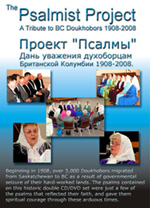 A
Discovery: The Psalmist Project.
A
Discovery: The Psalmist Project. 2009. English. NTSC DVD running time: 119 minutes. Format 4 x 3. By the Doukhobor Discovery Centre (previously: Doukhobor Village Museum), Castlegar, British Columbia, $30 plus $7 shipping and handling. In English, with a background of Russian psalm-singing. This Project is supplemented with an earlier double-CD set of psalm singing along with an extensive website in-progress — The Psalmist Project Video Directory.
Posted on YouTube in 2016 by Larry Ewashen.
The project was conceived in 2006 as a "modern-day, high quality digital compendium of 'Psalm-Singing'". Many Doukhobor volunteers wrote, produced, narated, and sang. Funding is shared by The Leon & Thea Koerner Foundation, the Columbia Basin Trust (via Kootenay Columbia Cultural Alliance) and the BC Arts Council. The DVD cover states that there were '25 interviews with over 360 rare images, maps, original sketches, 17 psalms and narration, all compiled into an educational, informative, and entertaining story in video format'.
Although this Project is a wonderful contribution to the understanding of the nature and role of Doukhobor psalm singing, or 'Soul Communion', as some practitioners have described it, there are a number of questions that are unanswered or missing (spirituality, Russian connection, Ivan F. Sysoev, Nick N. Kalmakoff, forecast) in this Project which I address in my review article: 'Doukhobor Psalm-Singing Rediscovered,' July 14, 2009.
See LIST
2009. English. 40 minute colour DVD. No Sub-titles. Writer, producer and narrator is museum consultant Katya Szalasznyj. $20 from the Doukhobor Dugout House, Box 433, Blaine Lake, Saskatchewan SOJ OJO, Canada.
Katya did her 1977 MA thesis on the Doukhobor Homestead Crisis 1899-1907, and speaks Russian. Her video includes interviews, archeology, history, photos, audio singing and reciting, the grand opening, other events, and an inside tour.
This is a story about survival of Russian Doukhobor migrants during their first years of settlement on the Canadian prairies. The northern Prince Albert / Blaine Lake area of Saskatchewan (some 70 miles from Saskatoon) was one of the new areas that the migrants were given. Lacking buildings materials, the immigrants quickly dug houses and work areas into the high river bank reinforced with lumber inside and out which provided protection from the winter snow. In Russian, an earthen cave dwelling are called zemlianka, from zemlia, meaning earth, or dirt. In this village, 48 families lived on both sides of the ravine for 5 years, using logs hauled up from the river below. On this site, 5 families of 40 people lived and worked. It is the only Doukhobor zemlianka preserved and restored.
Several stills of historical photos were used in the video, many of which I have in my own collection. The view of an 'aul' [mountain-side houses] in Kars was supposed to show that this was the example which taught Doukhobors to dig into the earth and create a zemlanka. The image is nice, but it is not quite a match to the discussion at hand. 'Aul's are villages, not zemlankas. Russian Doukhobor migrants were creative and innovative. They looked at their situation and built their shelters accordingly. Where wood was available, they built wooden houses. With stones they built stone houses in the Caucasus. In other places they used clay as the basic building materials for constructing clay buildings with wooden supports. Their experience in Kars was only one of many that influenced them.
Doukhobor singing from audio cassettes was interwoven periodically to provide tone. In one case Sam Popoff, the amateur historian, recited a Doukhobor psalm — and this was most appropriate because Sam encouraged his daughter Brenda Cheveldayoff to create the Dugout projct on his farm.
The video shows a brief clip on volunteers working in the archaeological dig. Professional archaeologist from the University of Saskatchewan Margaret Kennedy says that the locals were an important part of the work. Jon Kalmakoff speaks at the unveiling of a stone monument commemorating the Oospenia Spring. At the same event, keynotes speaker Norm Rebin talked about the value of collective memory and how proud he was to see the spirit of goodwill and brotherhood present here. A walkabout tour of the site with costumed guides followed, then a plough pulling re-enactment by Doukhobor women, all members of the Saskatoon Doukhobor Society. During the grand opening ceremonies, the Lieutenant Governor of Saskatchewan, Ms. Haverstock, stressed the important contributions that the Doukhobor pioneers made to the Province. The video of Haverstock was detracted by a strong winds.
Correction: The first contingent of 2,100 Doukhobors reached Halifax Harbour, Canada on January 20 (not 24 as stated in the DVD), 1899, before proceeding to St. John, New Brunswick on January 23 where they took trains to Western Canada. There are three glitches in the copy I reviewed in which the image paused for a few seconds.
This is a good vitual tour if you cannot do it in person. The Doukhobor Dugout House site is located 10 km off Highway 12 south of Blaine Lake. They are only open in the summer on Saturdays (10 am-5 pm), phone 306-497-3140. — This review is summarized from Virtual Tour of the Doukhobor Dugout House on DVD: A review by Koozma J. Tarasoff (January 25, 2010).
See LIST